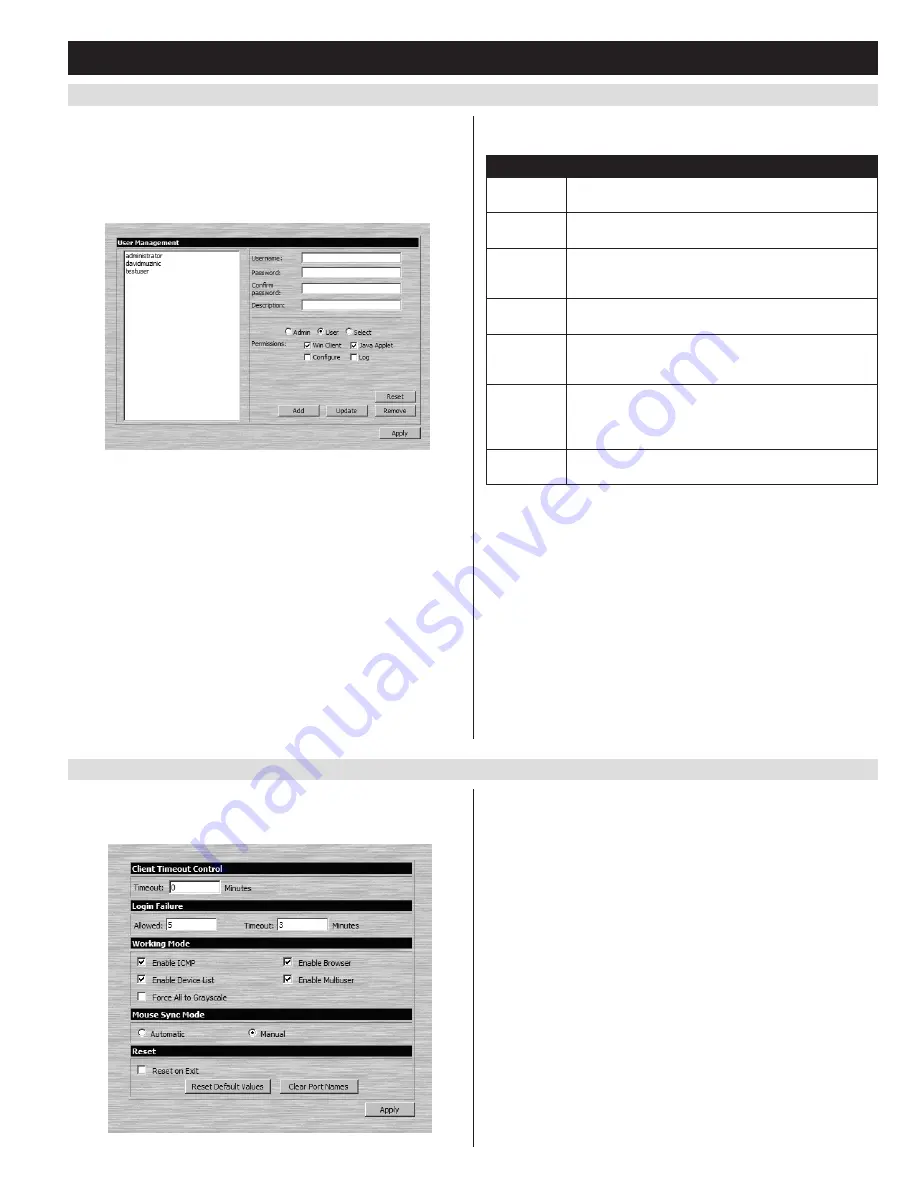
51
7. Administration
(continued)
7.3.5 User Management
The
User Management
page allows administrators to
Add
,
Edit
and
Delete
User
and
Administrator
accounts. Up to 64 accounts can be
established, with any combination of
Administrators
and
Users
. The
Port Access
settings can not be configured using the
Web Management
Interface
, and must be configured via the
Remote OSD
.
•
To add a new account, fill in the account information and click the
Add
button. The new account shows up in the list.
• To edit an existing account, highlight it in the list, and then update
the account information that appears on the right side of the page.
When all information has been updated, click on the
Update
button.
• To delete an existing account, highlight it in the list and click the
Remove
button. When clicking the
Remove
button, you are not
asked to confirm whether you want to delete the selected account. It
is automatically deleted.
• To clear the account information on the right side of the page
without affecting the selected account, click the
Reset
button. In
addition to clearing all account information, this de-selects any
accounts that were selected prior to clicking the
Reset
button. It’s as
if you just entered the
User Management
page for the first time.
• When you are done adding, updating or removing information from
the
User Management
page, click the
Apply
button to apply your
changes.
The table describes the account information fields and settings that are
found in the
User Management
page.
Setting
Description
Username
Enter the account username here. A minimum of 6 and
a maximum of 16 characters are allowed.
Password
Enter the account password here. A minimum of 6 and
a maximum of 16 characters are allowed.
Confirm
Password
Re-enter the account password here. If the two entries
do not match, you will be prompted to re-type the
password.
Description
Additional information about the user that you may
wish to include (optional).
Admin
Check this option to give the account
Administrator
access rights.
Administrators
have access to all
features and configuration settings of the KVM.
User
Check this option to give the account
User
access
rights.
Users
have access to both the
Windows Client
and
Java Client
, but do not have access to the
Log
Server
or
Configuration Settings
.
Select
Check this option to
Select
the account access rights
yourself. (See
Permissions
below for details.)
Permissions
The following permissions are included in the
User Management
page,
and determine what access rights are available to each account:
•
Win Client:
When selected, the corresponding account can access
the KVM switch using the
Windows Client i
n the
Web Management
Interface
and the non-browser
AP Windows Client
.
• Java Applet:
When selected, the corresponding account can access
the KVM switch using the
Java Applet
in the
Web Management
Interface
and the non-browser
AP Java Client
.
• Log:
When selected, the corresponding account can access the
Log
File
included in the
Web Management Interface
.
• Configure:
When selected, the corresponding account can access the
Administrator
settings in the
Local Console OSD
,
Remote OSD
and
Web Management Interface
.
7.3.6 Customization
The
Customization
screen allows administrators to configure settings
related to KVM operation. The sections that follow discuss the settings
you will find on this page.
Client Timeout Control
If there is no keyboard/mouse input for the amount of time specified
here, the logged-in user is automatically logged out, and must enter
their username and password in order to regain access to the KVM
switch. The default is 0, which disables the
Timeout
function.
Note: The Timeout function can only be set in the Web Management
Interface and the Local Console OSD.
Login Failure
• Allowed:
Enter into this field the number of unsuccessful login
attempts that will be allowed from a remote computer.
• Timeout (minutes):
Enter into this field the number of minutes a
user must wait before attempting to log in again after exceeding the
maximum number of unsuccessful logins.























